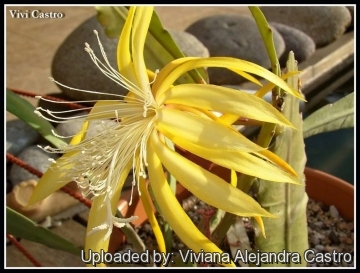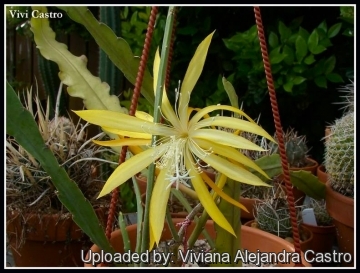
Epiphyllum cv. Fruhlingsgold Photo by: Viviana Alejandra Castro
Origin and Habitat: Hybrid.
Synonyms:
Common Names include:
ENGLISH: Hybrid Epiphyllum, Orchid Cactus, Epicactus
Description: Epiphyllum cv. Fruhlingsgold ( aka 'Fruehlingsgold', 'Frühlingsgold' or 'Fruhlings Gold' ) is a small to medium Epiphyllum hybrid with funnel form flowers. Narrow yellow petals with darker yellow outer petals and has a medium to intense scent of lemon. It is a profuse fragrant bloomer. This variety can have a dozen or more buds on just one stem, if all are left on the stem to become mature blooms they will be smaller 5-7.5 cm in diameter and possibly lighter in colour. If only one or two on a stem they can be up to 10-18 cm in diameter on average.
Habit: It has a medium thick flat growth. Stems unsegmented, unarmed, leaflike, rather succulent, erect to ascending, 2-winged, flattened for most of their length, lanceolate to long linear, terete, tapering at both ends, showing a very thick midrib, and becoming woody at base.
Derivation of cultivar name: The name means “spring gold” .
Hibridizer: Hybridized by Kurt Petersen. A cross of Epiphyllum cv. Reward x Disocactus macranthusSN|23621]]SN|23621]].
Blooming season: It is a profuse fragrant bloomer that flowers in late spring or early summer, remaining open for several days.
Notes: About Kurt Petersen The Epicacti hybridizer; Kurt Petersen’s hybrid creations all begin with either “Fruehling” (In German translates to “spring”) or Mai (which is German for “May”) as the first part in naming his hybrid creations. He primarily used Disocactus macranthusSN|8805]]SN|23621]] and Disocactus nelsoniiSN|23621]]SN|8805]] for his crosses. Many are also fragrant due to his use of D. macranthus as one of the parent crosses.
Bibliography: 1) © 2009, Mattslandscape.com Ephyllum hybrid 'Fruhlings Gold' Mattslandscape.com Specializing in Hybrid Epiphyllums <http://mattslandscape.com> Web. 2 Nov. 2014.
2) Dave's Garden contributors. "PlantFiles: Hybrid Epiphyllum, Orchid Cactus, Epicactus Epiphyllum 'Fruhlingsgold' ” Dave's Garden. <http://davesgarden.com> Web. Web. 2 Nov. 2014.
 Epiphyllum cv. Fruhlingsgold Photo by: Viviana Alejandra Castro
Epiphyllum cv. Fruhlingsgold Photo by: Viviana Alejandra Castro Epiphyllum cv. Fruhlingsgold Photo by: Viviana Alejandra Castro
Epiphyllum cv. Fruhlingsgold Photo by: Viviana Alejandra Castro Epiphyllum cv. Fruhlingsgold Photo by: Viviana Alejandra Castro
Epiphyllum cv. Fruhlingsgold Photo by: Viviana Alejandra CastroSend a photo of this plant.The gallery now contains thousands of pictures, however it is possible to do even more. We are, of course, seeking photos of species not yet shown in the gallery but not only that, we are also looking for better pictures than those already present.
Read More... Cultivation and Propagation: Epiphyllum cv. FruhlingsgoldSN|29282]]SN|29282]] is easy to grow and tolerates neglect. It makes a nice hanging basket and is suitable for growing in containers. It is a profuse fragrant bloomer. This plant (as with all Epiphyllum) prefers partial shade, and requires ample summer water (more than other cacti), but allow soil to dry slightly between waterings.
Growth rate: It is a moderate to fast grower depending on conditions and tend to be long lived.
Exposure: It need full sun to partial shade. Shade is sometimes provided in hot climates. Extra light in the early spring will stimulate budding.
Soil: Epiphyllums aren't usually too picky as to soil type, but because of their epiphytic nature, it is recommended to grow them in well-drained soil mix largely composed of organic material, such as peat or sphagnum moss. This type of soil would normally be used for orchids, bromeliads or other epiphytic plants.
Repotting: Like most that are heavy bloomers repotting imeadiately after blooming is recommended.
Waterings: During the growing season (March-August), the plants are watered on a regular basis, making sure that they never dry out completely. They are fertilized on a monthly basis with a balanced fertilizer during this period. In late August, water is restricted to about once a week until January. Night temperatures at this time should be about 10° C. In January or February, watering is stopped for a period of 4 weeks to aid in flower formation. In March, regular watering is resumed and the plant will flower in 6 to 8 weeks.
Remarks: These plants drop their buds easily if they are moved. Once flower buds have formed, DO NOT MOVE the plant, as slight changes in environment may cause the buds to drop..
Hardiness: Prefers nighttime temperatures no cooler than 12° C, especially in the winter. Will tolerate temperatures to 45° C, and short periods of frost, but prolonged cold will damage or kill the plant. Protect from frost. USDA Zone 9b to 11
Pests and diseases: Usually remains remarkably free from disease.
Propagation: It is propagated by stem cutting in the spring.














